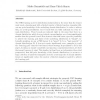Free Online Productivity Tools
i2Speak
i2Symbol
i2OCR
iTex2Img
iWeb2Print
iWeb2Shot
i2Type
iPdf2Split
iPdf2Merge
i2Bopomofo
i2Arabic
i2Style
i2Image
i2PDF
iLatex2Rtf
Sci2ools
TCS
2011
2011
Smart PAC-learners
The PAC-learning model is distribution-independent in the sense that the learner must reach a learning goal with a limited number of labeled random examples without any prior knowledge of the underlying domain distribution. In order to achieve this, one needs generalization error bounds that are valid uniformly for every domain distribution. These bounds are (almost) tight in the sense that there is a domain distribution which does not admit a generalization error being significantly smaller than the general bound. Note however that this leaves open the possibility to achieve the learning goal faster if the underlying distribution is “simple”. Informally speaking, we say a PAC-learner L is “smart” if, for a “vast majority” of domain distributions D, L does not require significantly more examples to reach the “learning goal” than the best learner whose strategy is specialized to D. In this paper, focusing on sample complexity and ignoring computational issues, we show...
Domain Distributions | Generalization Error | Prior Knowledge | TCS 2011 | Theoretical Computer Science |
| Added | 15 May 2011 |
| Updated | 15 May 2011 |
| Type | Journal |
| Year | 2011 |
| Where | TCS |
| Authors | Malte Darnstädt, Hans-Ulrich Simon |
Comments (0)

